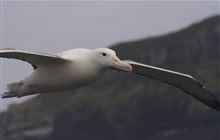Fitting name for famous albatross chick
Archived content: This media release was accurate on the date of publication.
Introduction
The royal cam albatross chick at Pukekura/Taiaroa Head has been named Moana.Date: 21 June 2016
Announcing the winning name, the Department of Conservation's threatened species ambassador Nicola Toki said Moana is the Māori name for ocean, sea, wide expanse of water. He manu o te moana means a bird of the sea.
"Northern royal albatross/toroa spend most of their lives at sea, covering vast areas of the ocean in search of food and returning to land only to breed and raise their young, so this Māori name represents this type of bird very well," Nicola said.
Room 7 from Tainui School in Dunedin sent the winning entry. The class wins a trip to the Albatross Centre. There were 13 entries for Moana and DOC staff picked one entry to win the trip.
DOC received 2437 entries for the chick naming competition from all over the world. There were 1225 votes for the name. The names had to reflect the characteristics of the species or their habitat on Otago Peninsula and their importance as a taonga (treasure) species.
DOC rangers have also confirmed the chick is a female.
Background information
The albatross chick at Pukekura/Taiaroa Head has become an internet sensation. Thousands of people throughout the world have been watching the chick on a web cam since it hatched in January.
Te Poari a Pukekura (the Pukekura Co-management Trust) chose the top five names and the final winning name was decided by public vote. 13 entries were received for the name Moana, so the winner was drawn at random by DOC staff.
Since the chick hatched in January, the royal cam webpage has received 377,654 views and 11,507 comments. The cam has received 392,587 views on YouTube. This equates 7,314,764 total minutes watched – that's 13 years and 331 days. These numbers are increasing significantly every week.
We hope to film the chick until it fledges (is ready to fly), about September. The chick is currently left alone on the nest for long periods while its parents are at sea foraging for food.
Northern royal albatross are a vulnerable species and an icon of Dunedin. They are a taonga species for Ngāi Tahu. With a wing span of over three metres, Northern royal albatrosses are among the largest seabirds in the world.
After the chick fledges, its parents will leave the colony and spend the following year at sea. They then return to breed again, completing a two-year cycle.
The Royal Albatross Colony is the only mainland place in the world to view Northern royal albatross in their natural habitat. There are more than 150,000 visitors a year to the site.
DOC manages the Northern royal albatross colony with the support of the Otago Peninsula Trust, Te Poari a Pukekura (Pukekura Co-management Trust) and Dunedin City Council. The colony has benefited from decades of DOC's management and predator control. It has grown from one breeding pair in 1937 to about 50 pairs in 2015. 10,000 seabirds are also thriving at Taiaroa Head, including nationally vulnerable and threatened species like red-billed gulls and Otago shags.
Contact
For media enquiries contact:
Email: media@doc.govt.nz

